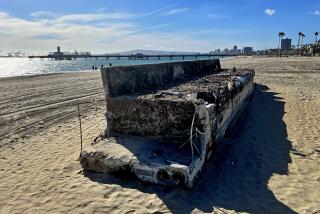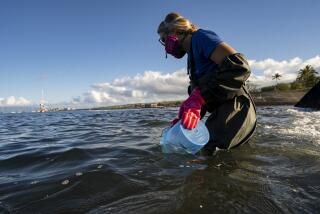In Laguna Beach, kelp has arrived -- and it’s raising a stink
Warmer air and water temperatures, combined with overseas tropical storms, delivered an ecologically desirable but olfactory disagreeable gift to the shores of Laguna Beach this summer: copious amounts of kelp.
City officials and environmentalists say that the last few months were unlike any others recently because of the sheer amount of seaweed that collected in piles, called wracks, on Laguna’s downtown Main Beach and at nearby Crystal Cove State Park.
Some thought the pungent piles were too much, even in an eco-conscious artists’ village that annually celebrates seaweed with a springtime Kelpfest.
But keep in mind that the slimy bundles are living ecosystems, marine biologist and kelp aficionado Nancy Caruso said.
Caruso has led a decade-long mission to revitalize the sea plant in forests off Laguna Beach and Newport Beach and is recognized for organizing the kelp festival, which educates the public on the plant’s environmental benefits.
The wracks, she explained, play a pivotal role in the food chain. Beach hoppers, also known as sand flies, nibble on the seaweed and hide in the piles. In turn, those tiny invertebrates become a food source for shorebirds.
Kelp is often pulled back into the ocean by high tides, releasing reproductive spores. The process allows nutrients to seep into the sand as well.
The kelp that washed ashore in recent months is the most that Steve May, Laguna’s public works director, has seen since he started working for the city in 1995.
Caruso attributed the increase to warmer sea temperatures and storm swells that dislodged kelp from reefs.
Warmer water from the tropics has fewer nutrients, which starves the kelp and releases it from the reefs, sending more of it through the Pacific and onto California beaches, according to experts.
“On top of [the warmer water], we had more south swells this summer than I can remember,” Caruso said. “All of that created lots of kelp on the beach.”
She noticed something drastically different while scuba diving off Crystal Cove in late August, when Hurricane Marie off Baja California created massive waves along Orange County beaches.
The storm “ripped out 98% of the kelp from the reef,” said Caruso, explaining that the disgorgement would foster new plant growth.
To keep beaches clean, city crews occasionally scoop up wracks and take them to Laguna Canyon, where they are left to dry in the sun.
Once dried, the kelp is taken to the Waste Management recycling facility in Irvine, where it is combined with other “green waste” materials such as tree branches and leaves, said company spokeswoman Eloisa Orozco. It’s then taken to another facility where it is turned into landfill cover, she said.
Caruso would like to see recovered kelp used for other purposes, such as biofuel or fertilizer, though she said that leaving it undisturbed on the shore, waiting for the tide to return it to the ocean, is also a good option.
Though many find kelp’s aroma a bit too pungent, Caruso thinks it “smells good.”
“I want people to understand that kelp is supposed to be here,” she said.
Alderton writes for Times Community News.
More to Read
Get the Latinx Files newsletter
Stories that capture the multitudes within the American Latinx community.
You may occasionally receive promotional content from the Los Angeles Times.







